
Whether you’re a grizzled ADV veteran or a new rider feeling dirt-curious, we can all agree that lighter, more compact bikes deliver their own special brand of fun.
If you’re looking for the best lightweight adventure bikes to take for a spin this year, we’ve got you covered.
What You Should Look For In A Lightweight Adventure Bike
Pretty much anything looks light sitting next to the latest KTM 1290 Super Adventure or Ducati Multistrada V4, but you’ve gotta draw the line somewhere.
Are all middleweight ADVs considered lightweight adventure bikes? Do they need to be under 500cc? What about things like fuel capacity, seat height, and luggage options?
 "On the lookout for pioneers on our Best Week in Oregon Trip"
"On the lookout for pioneers on our Best Week in Oregon Trip"We’ve been running tours on adventure bikes of every description imaginable from small-bore dual sports to big honkin’ BMW GSAs for over a decade at this point, and our experience has given us a certain “criteria” we aim for when looking for the ideal lightweight ADV rig.
Here are the cliff notes on what our experience has taught us.
Curb Weight
Motorcycle weights come in two flavors: The “dry” spec that manufacturers would have you believe and the curb or “wet” weight of the bike when it’s actually full of gas and in proper running order.
This is an important distinction to make, because by the time gas, coolant, oil, and blinker fluid have been added to your machine, the total weight can easily grow by 30 pounds or more.
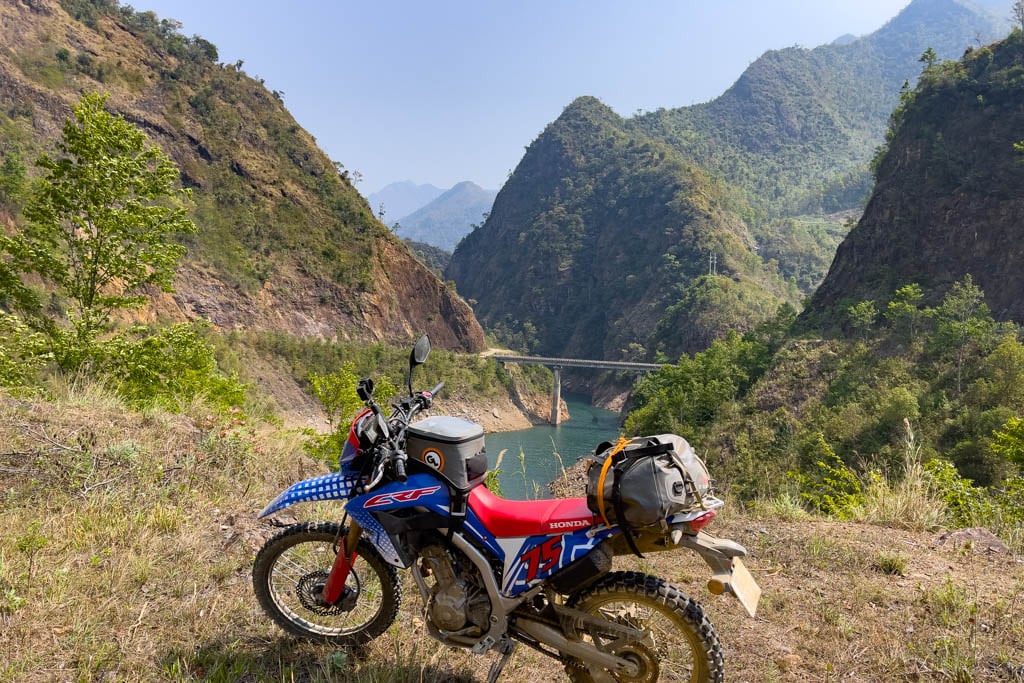 "Keeping it light on the CRF 300L on our last trip to scout routes in Vietnam"
"Keeping it light on the CRF 300L on our last trip to scout routes in Vietnam"To that end, we consider bikes that tip the scales under 400 lbs fueled to the brim to be lightweight adventure bikes.
The lower you can get the better, of course, but that’s where we draw the line when we’re looking for a more manageable and maneuverable machine.
Highway Cruising Speed
Now that we’ve got the actual weight figure out of the way, let’s talk about the specific features we look for on any bike we consider adventure-ready.
The first one is highway cruising speed, which is particularly important considering you’ll be covering some long miles on any proper adventure.
 "Sometimes it's nice to cruise slow and take it in... Not so much on the super slab..."
"Sometimes it's nice to cruise slow and take it in... Not so much on the super slab..."Generally speaking, we want a minimum comfortable cruise of about 70mph.
Lighter bikes tend to feature smaller and less powerful engines, so while manufacturers may claim a top speed of 70, 80, or even 100mph, pushing a small bike to those speeds can create harsh vibrations that kill your vibe in short order on the open freeway.
Wind Protection
Another important element to consider for those long highway stretches is wind protection.
Even a Sportster feels fine up to 60mph or so, but as you climb into the upper register, wind on your shoulders, head, and neck takes a toll on your body, and will leave you sore before the end of your first day on the road.
 "Nothing quite like a big windshield while rolling 70+ mph"
"Nothing quite like a big windshield while rolling 70+ mph"For that reason, we look for a sizable windscreen on any lightweight adventure bike we’re considering, and some front fairing is great as well if we can get it.
Granted, windshields can typically be added or upgraded in the aftermarket, but if you’re looking for an “out of the box” ADV, wind protection is a must.
Luggage Options
Traveling on two wheels is no different than driving, flying, or hiking in that you’ll need to take a few essentials with you anywhere you go.
For some riders that means camping gear and three square meals a day, while others can often get away with spare clothes, rain gear, and a simple tool kit.
 "Fully loaded while on the California BDR. Not our favorite moment waddling through deep washout"
"Fully loaded while on the California BDR. Not our favorite moment waddling through deep washout"Regardless of where you fall on the spectrum, you’ll want to ensure you’re able to carry all your stuff on your bike.
Some lightweight adventure bikes offer bags from the factory while others require aftermarket intervention, either by adding soft luggage or buying aftermarket luggage racks for saddlebags and top cases.
We recommend figuring out how much space you need, and then evaluating any potential ADV candidate from there. If your bike of choice either comes with all the storage you need or has an aftermarket option that works with your budget, it’s a green light for us.
Range
Last but not least, let’s talk about range. Range is the combination of fuel capacity and fuel efficiency, and ideally, we like to see adventure bikes go for around 200 miles between fill-ups.
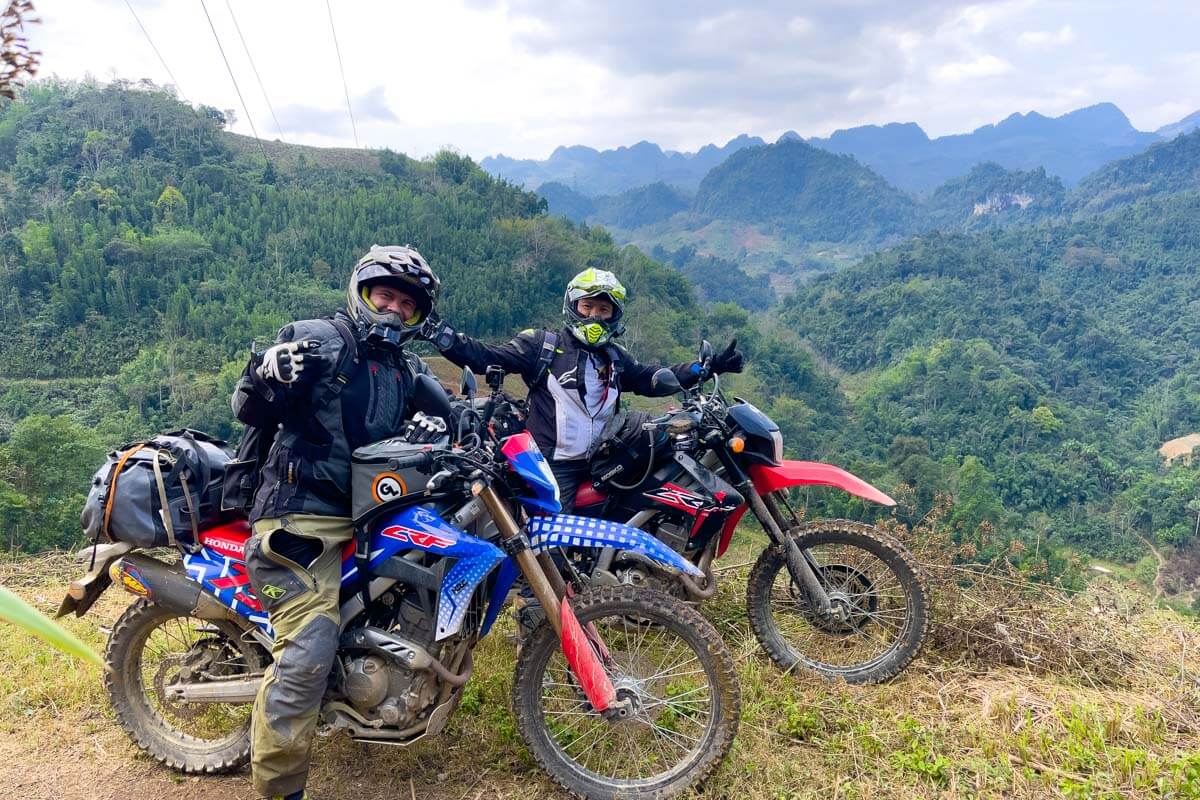 "In rural Vietnam it's essential to understand the range of your bike between fillups."
"In rural Vietnam it's essential to understand the range of your bike between fillups."This ensures you’ll likely only need to make one fuel stop a day, and also gives you peace of mind when you’re going off the grid to explore remote locations without any nearby service stations.
Again, there are aftermarket options for extending range including larger tanks, fuel canisters, and even foldable fuel bladders, but whatever angle you take, you don’t want to be constantly worrying about that low fuel light when you’re on a long trip.
The Best Lightweight Adventure Bikes
Keeping the above criteria in mind, there are actually only a few bikes we’d consider for lightweight adventure duty on the market today.
Some deliver the goods straight off the showroom floor while others require a little tweaking for long-range performance, but they’ll all get the job done if you’re looking for long trips with the occasional dirt interlude thrown in the mix.
KTM 390 Adventure R
- Wet weight: 386 lbs
- Performance: 44.4 hp/28.8 lb-ft torque
- Cruising speed: Around 75mph
- Wind protection: Yes
- Range: 3.7 gallons/248 miles
- MSRP: $7,599
 Photo: KTM
Photo: KTMPros:
- Premium features and components.
- Comfortable for the long haul.
- Great range for a small bike.
Cons:
- New model = unknown long-term reliability
- Taller 34.5-inch seat isn't for everyone
KTM's original 390 Adventure has always had a home on this list thanks to its premium build, advanced electronics, and quality WP suspension. It always needed more travel, better ergos, and a 21" front to truly compete, though.
KTM decided to give the people what they want this year in the form of the new 390 Adventure R. With a spoked 21/18" wheel combo, long travel suspension, good wind protection, and sharp ADV styling, they've hit the ball out of the park here.
 "The 390 R is more capable and less expensive than the previous 390 Adventure. Win-win." photo: KTM
"The 390 R is more capable and less expensive than the previous 390 Adventure. Win-win." photo: KTMPerhaps most important is the fact that the new 390 Adventure R actually costs less than the original by a whopping $600.
So we're getting a better looking, more capable, and more versatile machine at a price that's much closer to Japanese alternatives.
You're still getting a comfortable 75mph+ cruising speed, lean-sensitive electronics, and premium components like handguards and a skidplate as standard, but the new 390's off-road prowess is significantly improved from gravel to single-track.
Honda CRF300L Rally
- Wet weight: 331 lbs
- Performance: 27 hp/19.6 lb-ft torque
- Cruising speed: 70 mph
- Wind protection: Yes
- Range: 3.4 gallons/ 250+ miles
- MSRP: $6,499
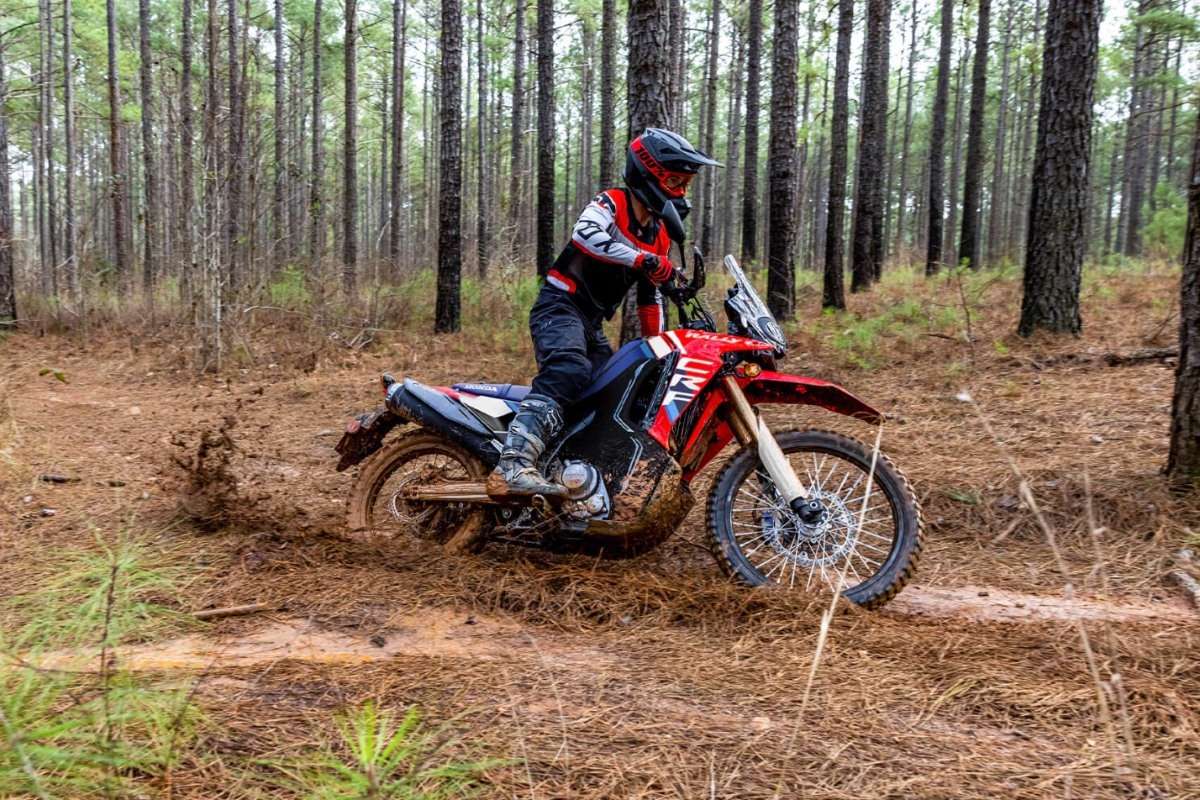 "photo credit: Honda"
"photo credit: Honda"Pros:
- Real off-road chops
- Buttery smooth
- Torquey powerplant
- Good bang for the buck
Cons:
- Vibrations over 70mph
- Factory skidplate/hardguards are flimsy
If any featherweight bike truly deserves the adventure title, it’s the Honda CRF300L Rally.
Updates for 2025 have improved suspension performance on road and off as well, solving our single biggest gripe with the little Rally.
The Rally is built on the bones of the standard 300L dual sport, but it’s so much more than a dirtbike with a rally-style fairing.
Range is extended to a whopping 250 miles, handguards and even a skid plate (albeit very basic ones) come stock, and the brake rotors are larger than the standard dual sport to help handle its extra fuel and weight.
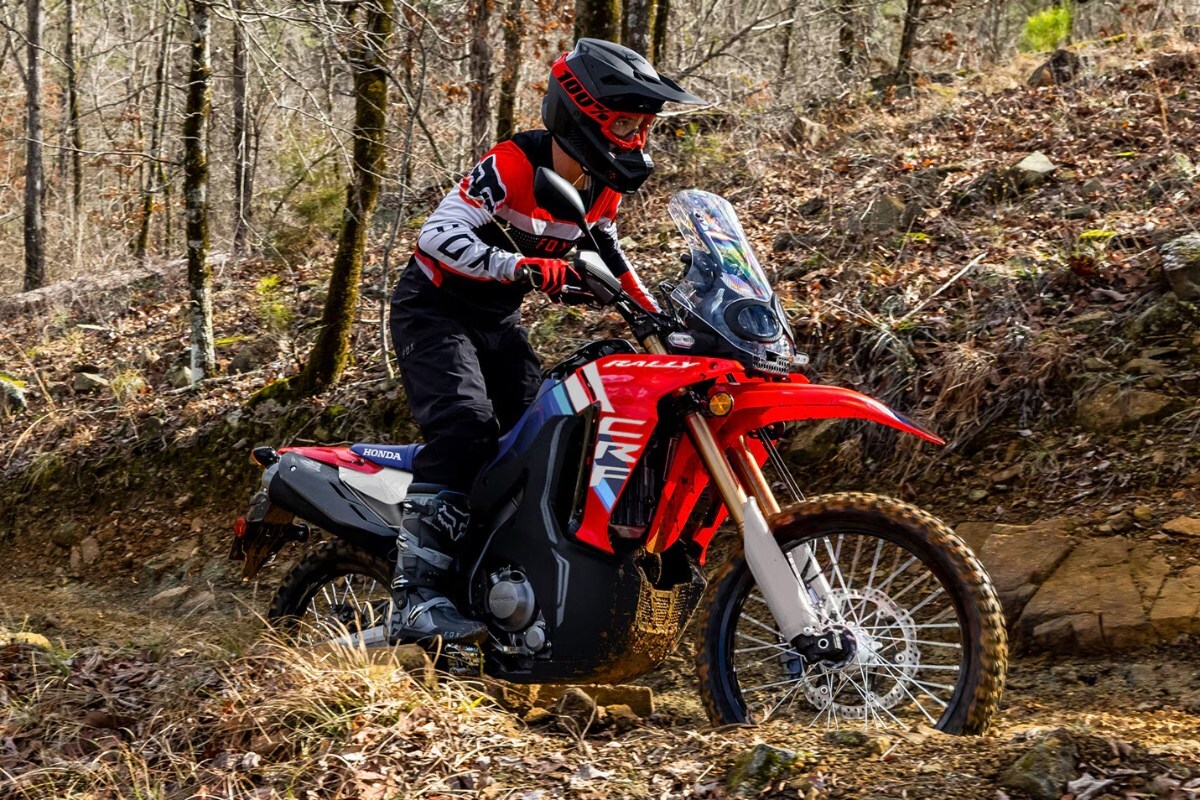 "Honda has firmed up the Rally's suspension for 2025, solving our single biggest complaint with the bike." photo credit: Honda"
"Honda has firmed up the Rally's suspension for 2025, solving our single biggest complaint with the bike." photo credit: Honda"We love that Honda managed to pack over 10 inches of suspension travel into this lightweight adventure bike as well. Combined with its proper 18/21 inch wheels and knobby tires, the 300L Rally holds its own in the dirt against pure dual-sport bikes.
We will note that above 70mph the Rally’s windshield starts to give up the ghost protection-wise, but pushing a lightweight bike with knobby rubber any faster than that is sketchy to begin with, so we can’t really fault it there. The price also increased $300 for 2025.
Suzuki DR650S
- Wet weight: 366 lbs (166kg)
- Performance: 43hp/47lb-ft torque
- Cruising speed: 70 mph
- Wind protection: No
- Range: 3.4 gal/ 175 miles
- MSRP: $7,099
 "photo credit: Suzuki official website"
"photo credit: Suzuki official website"Pros:
- Affordable.
- Incredibly reliable.
- Easy to convert into an outstanding adventure bike.
Cons:
- Bare bones design/zero tech.
- The stock seat is made from concrete and roofing nails.
An oldie but a goodie. Because Suzuki is still technically building the DR650 this year, there’s no way we’re going to leave it off a list of lightweight adventure bikes.
As you might have noticed glancing at the specs, this one comes with a few caveats: It’s got zero wind protection, and it doesn’t quite deliver the range we’re after either.
Lucky for prospective DR owners, this bike has one of the largest and most enthusiastic aftermarkets on the planet.
Both extended-range fuel tanks and bolt-on windshields are readily available, but those are only the tip of the iceberg of what’s available when transforming the big dual sport into a proper long-range adventure machine.
 "A solid lightweight adventure bike for those long rides, even if there are a few tube changes along the way."
"A solid lightweight adventure bike for those long rides, even if there are a few tube changes along the way."We’ll also note that while you can definitely snag a shiny new DR from the dealer today, shiny used ones go for about half the price, and chances are they'll already have most of the aftermarket parts you want as owners love to upgrade these machines.
In our experience, it only takes about $2,000 to completely transform a stock DR into a more powerful, more comfortable, and more capable adventure rig, and it's one that’ll last you for a lifetime of regular use and abuse to boot.
Royal Enfield Himalayan 450
- Wet weight: 432 lbs
- Performance: 40 hp/29.5 lb-ft
- Cruising speed: 75 mph
- Wind protection: Yes
- Range: 270+ miles/ 4.5 gallons
- MSRP: $5,799
 photo: Royal Enfield
photo: Royal EnfieldPros:
- Affordable
- Exceptionally well-rounded
- Nails the ADV basics from the factory
Cons:
- TFT display takes practice to navigate
- More compact than your average 450
Forget everything you know or have heard about the Royal Enfield Himalayan: the completely redesigned Himalayan 450 is one of the best lightweight adventure motorcycles we've ever thrown a leg over.
Where the old Himalayan 400 was low on power, suspension, tech, and refinement, the new Himalayan 450 excels. The price is still extremely affordable, but all the old compromises in performance and modernity are gone.
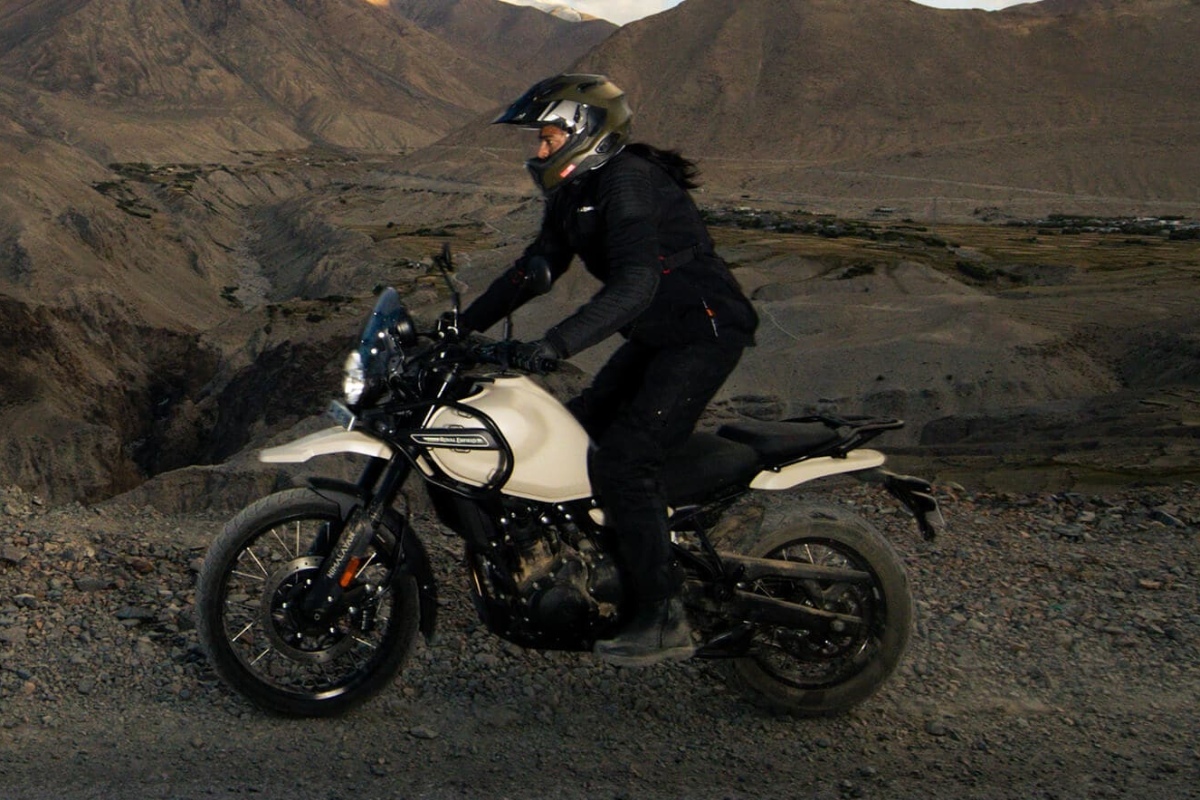 "The new Himalayan combines outstanding long-range comfort for a single-cylinder with solid off-road performance." photo: Royal Enfield
"The new Himalayan combines outstanding long-range comfort for a single-cylinder with solid off-road performance." photo: Royal EnfieldThe new Sherpa 450cc engine makes great power for a liquid-cooled single, and will actually accelerate uphill in top gear now.
The Showa suspension is incredibly well-damped from the factory, and its 7.9 inches of travel work well, even on single-track trails.
The new Himi even has a solid electronics package including a full-color TFT dash with integrated navigation, switchable ABS, and multiple ride modes.
None of it is cutting edge, mind you, but it's downright impressive for a sub-$6,000 machine.
 We've taken these things far and wide without a single issue over the last year and can't praise them enough for the money.
We've taken these things far and wide without a single issue over the last year and can't praise them enough for the money.
They're much better off-road than you'd expect, and will go anywhere a CRF300L will, albeit with much better highway manners.
Kawasaki Versys-X 300
- Wet weight: 386 lbs
- Performance: 39.3 hp/ 19.2 lb-ft torque
- Cruising speed: 65
- Wind protection: Yes
- Range: 250 miles/4.5 gallons
- MSRP: $5,699
 photo: Kawasaki
photo: KawasakiPros:
- Full factory adventure kit available
- Budget-friendly
- Light, nimble handling
Cons:
- Needs revs to make power
- More revs = more vibration
- Basic suspension
Riders often forget that Kawasaki was making a compact, parallel-twin-cylinder adventure bike long before such things were en vogue.
The Versys X-300 is a budget-friendly, adventure-friendly, and exceptionally well-rounded.
We love that Kawasaki includes a windshield and a rear rack as standard equipment, as well as an affordable option for 17-liter waterproof hard bags and a 30-liter top case. Add it all together and you've got a cross-country machine for about $6,300.

"The Versys-X 300 is a great all-rounder, and ideal for the daily commute." photo - Kawasaki
We dig the Versys' sharp handling, which makes it fun to flick around on the pavement but also surprisingly easy to handle on dirt roads and narrow trails.
We'll also note that the Versys easily returns 50+ mpg, so range is a non-issue wherever you go.
As for drawbacks, our biggest complaint historically has been the Versys' engine, which is capable, but requires a ton of revs to make usable power. You can technically do 75mph on the freeway with it, but anything over 60-65mph feels like torture.
CFMoto Ibex 450
- Wet weight: 425 lbs
- Performance: 44 hp/ 32.5 lb-ft torque
- Cruising speed: 70+
- Wind protection: Yes
- Range: 250+ miles/4.6 gallons
- MSRP: $6,499
 photo: CFMoto
photo: CFMotoPros:
- Fully-adjustable long-travel suspension
- Huge value
- Parallel twin power
- Great factory equipment
Cons:
- Buzzy over 70 mph
- Rudimentary electronics
- Wind protection needs a little love
CFMoto's Ibex 450 has earned the nickname "the mini Tenere" due to its full-size frame and small-bore parallel twin engine. It's also comparatively simple and surprisingly good off-road, just like a T7.
We added a few of these machines to our rental fleet this year, and overall, we're big fans of the Ibex 450. It's truly ready-to-go right out of the box, including an adjustable windshield, handguards, a skid plate, and folding mirrors for off-road use.
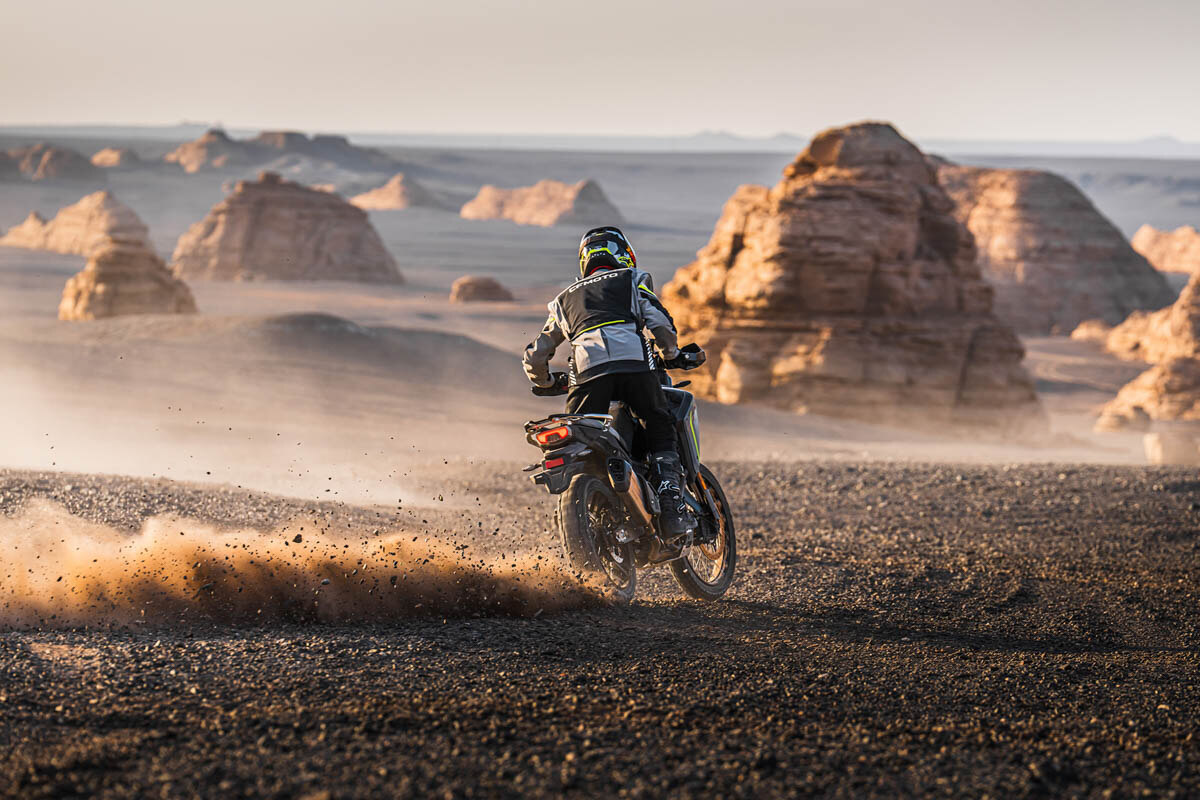 "The Ibex 450 punches well above its $6,500 price with real suspension, a full color dash, and real all-terrain performance." Photo: CFMoto
"The Ibex 450 punches well above its $6,500 price with real suspension, a full color dash, and real all-terrain performance." Photo: CFMotoPerhaps most impressive, however, is the Ibex's fully adjustable KYB suspension, which is damped firmly enough for serious off-road use.
The bike happily cruises at 70 mph all day, and while it's a bit over 400 pounds, it feels properly light between the knees.
As for drawbacks, we do have a few. The Ibex gets pretty buzzy over 70 mph, some extra wind protection would be ideal, and the seat isn't great.
Unfortunately, there's also a lack of aftermarket support, so there isn't an immediate solution for every issue.
The Last Word on Lightweight Adventure Bikes
In summary, lightweight adventure bikes offer a perfect balance between on-road comfort and off-road capability, making them an excellent choice for riders of all levels.
Their agility, affordability, and evolving technology ensure they remain a compelling option for those seeking adventure.
 "So gear up and hit the open road - your adventure awaits!"
"So gear up and hit the open road - your adventure awaits!"I hope this article helps you find the perfect lightweight adventure bike for your next adventure.
RIDE on everyone.
→Read More: Best Adventure Bikes on the Market 2025
6 Motorcycle Batteries That Outperform Your OEM.










